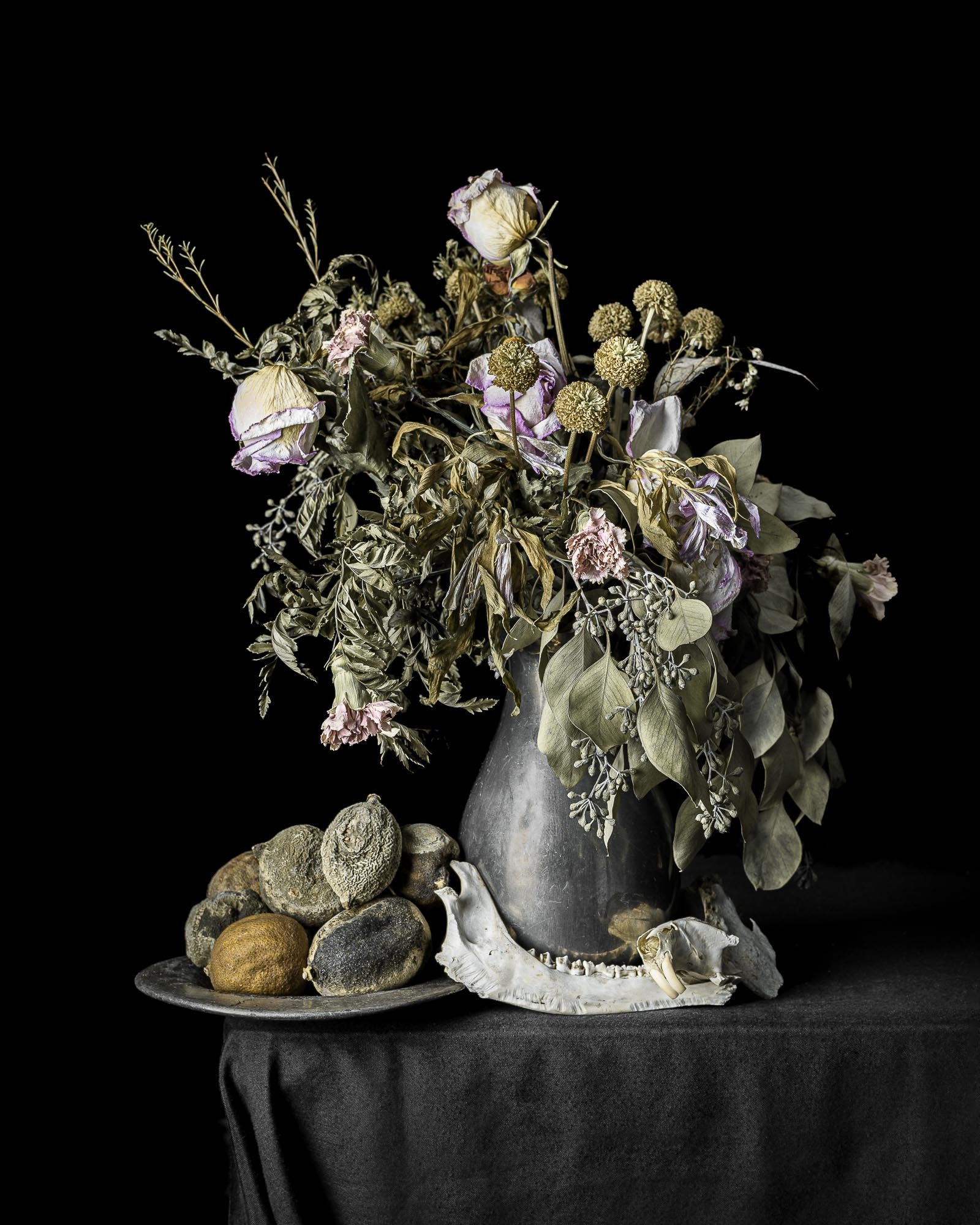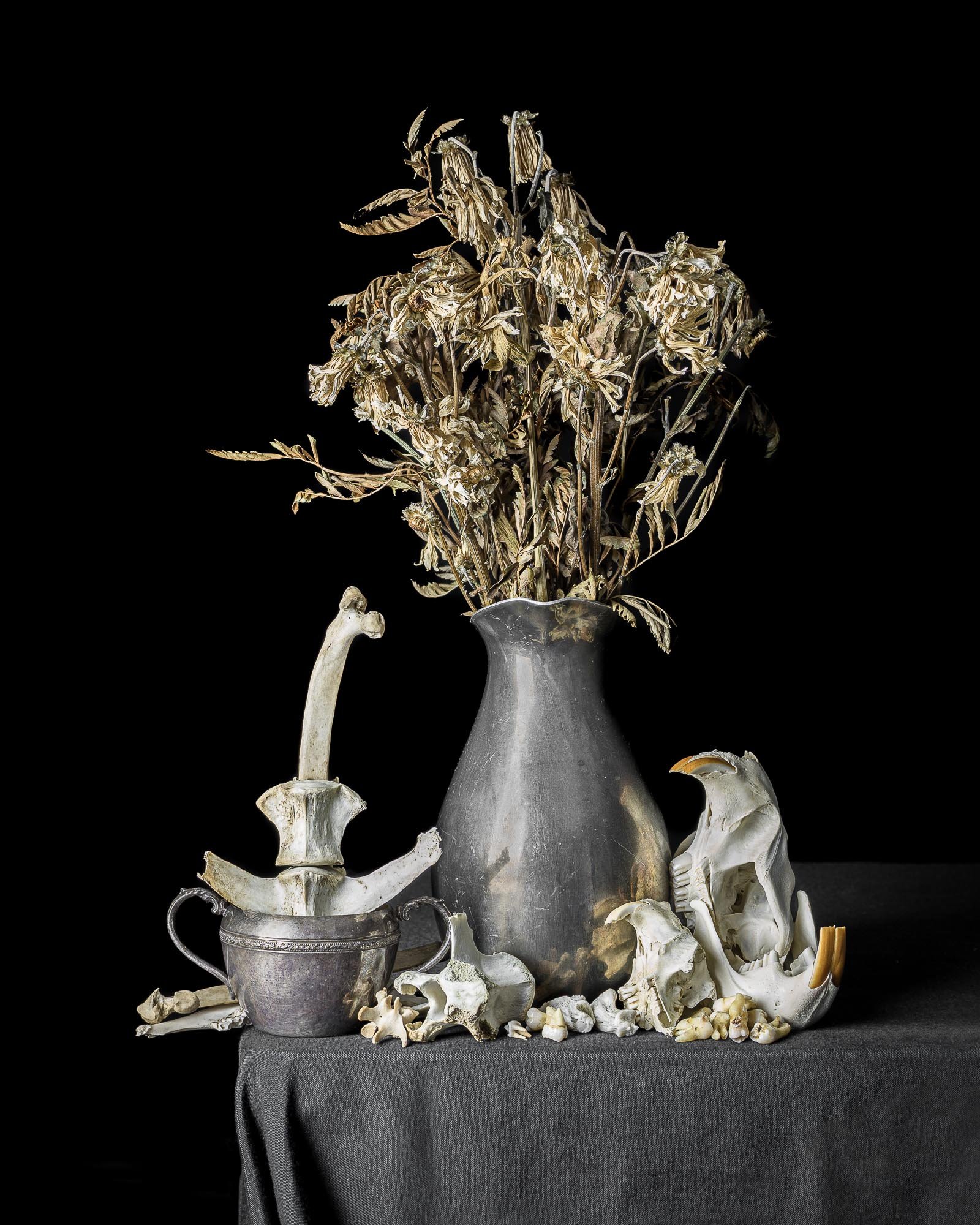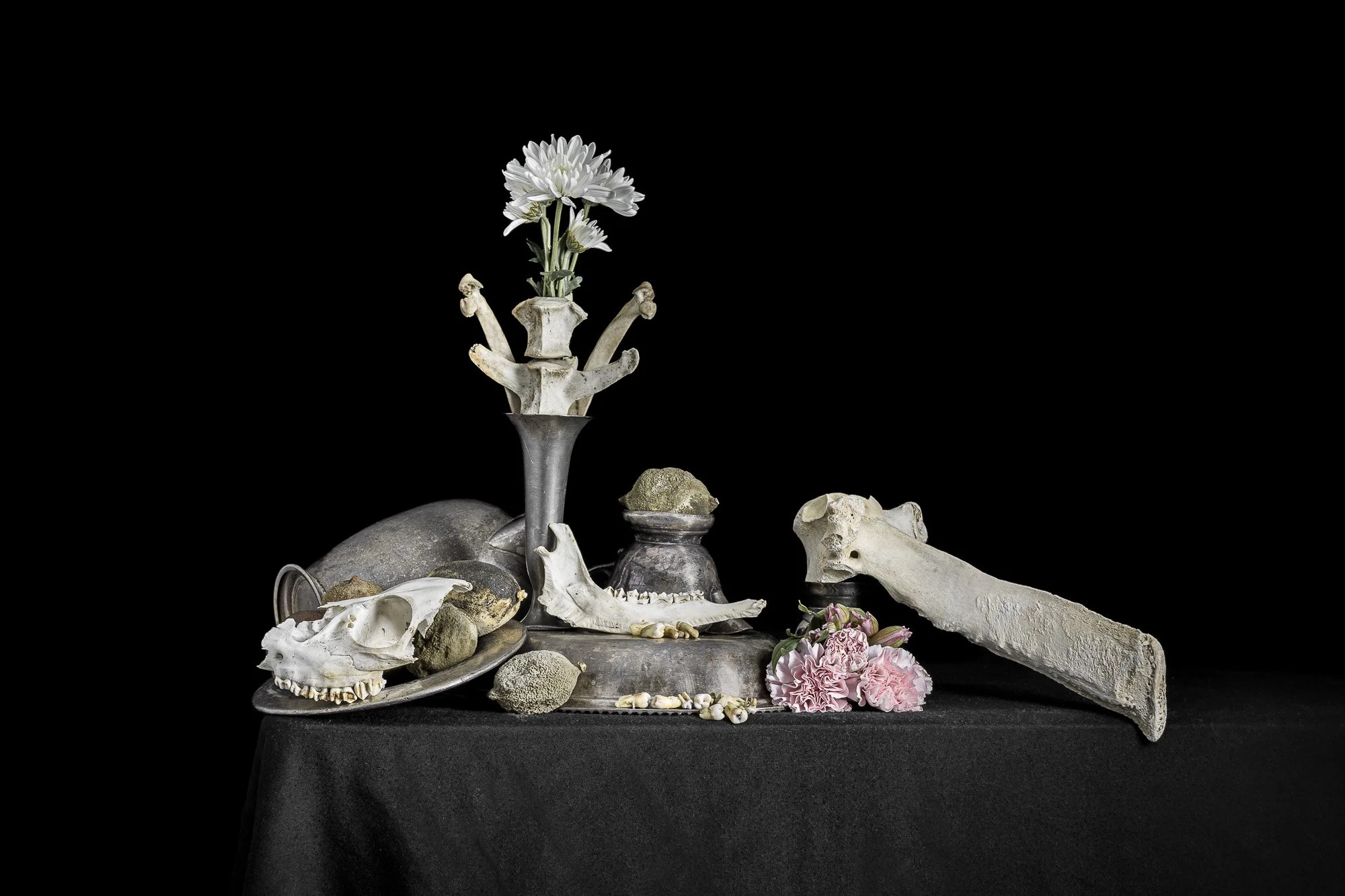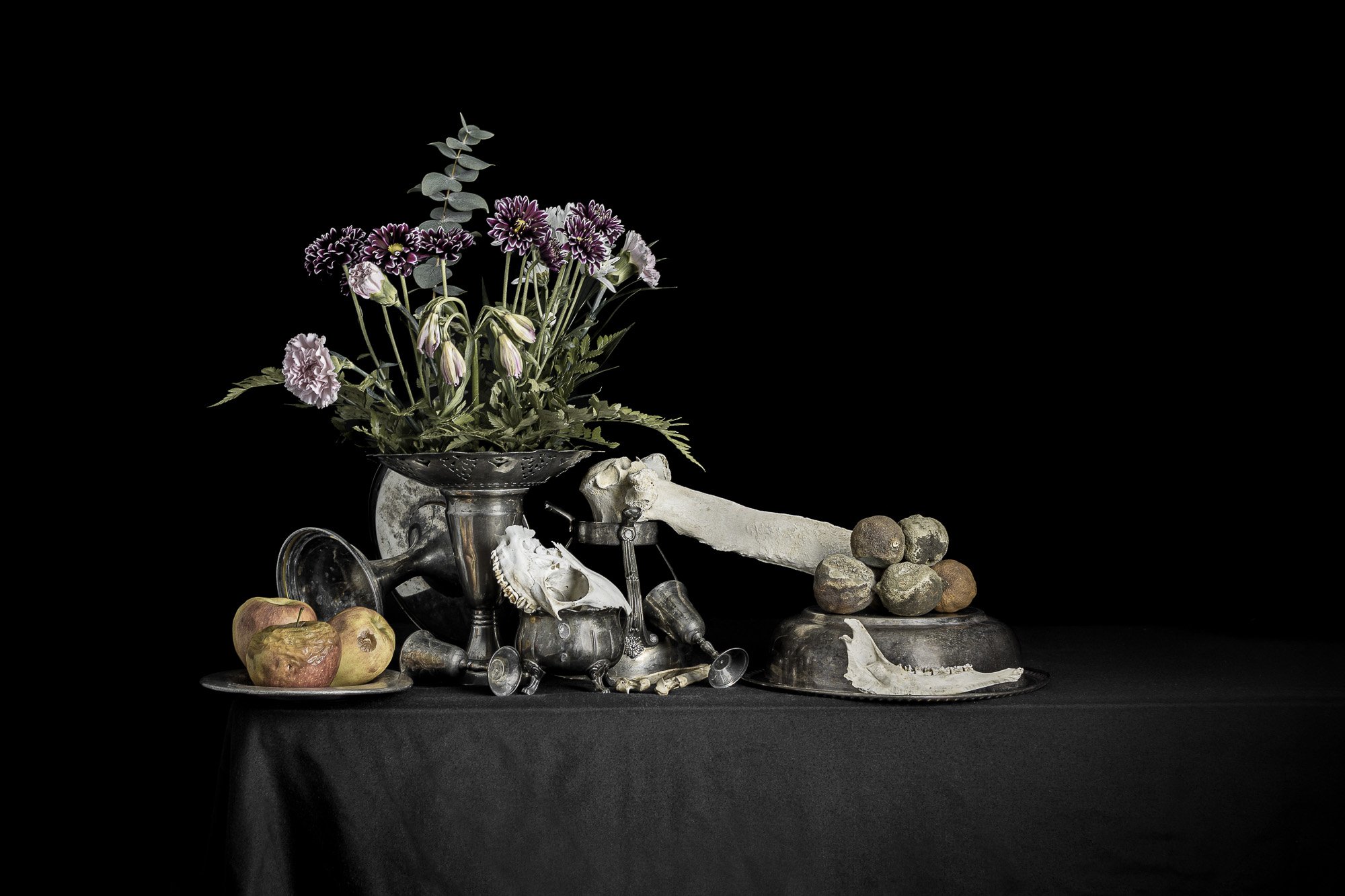Dry Bones
Vanitas with Dry Bones and Flowers, by Neal Auch
In one of several strange visions recounted in the Book of Ezekiel, the prophet finds himself in a desert valley, surrounded by the sun-bleached bones of the dead.
“Son of man,” God addresses Ezekiel. “Can these bones live?”
“Sovereign Lord, you alone know.”
God then commands Ezekiel to prophesy onto the dead. As he speaks, the wind in the valley rises, carrying up the bones with a hollow rattling sound and setting them against one another. What Ezekiel described next seems very much like a time-lapse video of the decomposition process being played in reverse: in awe, he watches as flesh and tendons emerge, unfurling from the matrix of the bones to bind them together. Finally, flesh and organs and skin are reconstituted, and the prophet finds himself standing before a sea of corpses.
Again, God commands Ezekiel to prophecy to the dead. “Come, breath, from the four winds,” he says. “Breathe into these slain, that they may live.” With these words, the dead are resurrected, and they rise to stand at attention before Ezekiel—a vast army.
In scriptural context, this hallucinatory episode is almost certainly meant to be read metaphorically. Ezekiel was a priest who had been exiled from Jerusalem following an attack on the city. While sitting on the banks of an irrigation canal in a Babylonian refugee camp, Ezekiel was visited by his first divine vision: a glowing humanoid figure riding a chariot being carried by four winged, four-headed creatures, each riding a glowing wheel. He would later learn that this surreal representation of God’s glory had abandoned its usual place in the temple, above the arc of the covenant, because the people of Jerusalem had been worshipping false idols and violating their covenant agreement. Although Ezekiel tried to warn his people of Jerusalem’s imminent destruction, his message was ignored. Not long after this vision, a recent refugee confirmed Ezekiel’s fears: Babylon had attacked Jerusalem; the city had fallen; the temple lay in ruins.
Ezekiel’s vision of the dry bones comes in this wake of the temple's destruction, and is meant to offer a vision of hope for the future. Indeed, God spells out the meaning of this vision rather explicitly. “These bones are the people of Israel. They say, ‘Our bones are dried up and our hope is gone; we are cut off.’ Therefore prophesy and say to them: ‘This is what the Sovereign Lord says: My people, I am going to open your graves and bring you up from them; I will bring you back to the land of Israel.’” In other words, the vision of the dry bones is a visual metaphor—a hopeful image meant to convey God’s promise to restore glory to a defeated and exiled people.
Vanitas with Dry bones and Flowers, by Neal Auch
Images of rebirth and renewal appear many times in the bible, from the creation of man from dirt and divine breath in Genesis, to Ezekiel’s vision of the dry bones, to Jesus raising Lazarus from the dead, to the resurrection of Christ. I would argue that there is something in these stories that transcends Christian ideology. Fundamentally, these are all stories about the possibility for new life to emerge from the ruins of the old. These are stories of hope and perspective; they are narratives that emphasize the kernels of beauty and glory that are always present, even in the midst of death and decay. Of course, these themes are also very much at the core of my own artistic output.
The sequence of still life arrangements that accompany this essay are inspired by Ezekiel’s vision of the dry bones. Here, I am less interested in the specific historical/religious context of that story and more interested in the broader lesson—the idea that, with a little effort, even dry bones can be made beautiful once again.
Vanitas with Dry Bones and Fruit, by Neal Auch
An Unnecessarily Deep Read of the Dry Bones Vision
While I’m certainly not religious by any stretch of the imagination, I do think that there are a few interesting truths that can be gleaned from a (perhaps unnecessarily) deep reading of Ezekiel’s text.
The first thing that stands out to me is how theatrical the dry bones story is. Instead of simply saying “I’m going to bring you back to the land of Israel,” God choses to present Ezekiel with this dramatic visual metaphor. It seems to me that the author of this text is acknowledging something very profound about how human brains work: showing is more powerful than telling. God speaks to Ezekiel in metaphors and imagery for exactly the same reason that artists and writers and politicians use those devices—it is the a very powerful way to convey a message. (If you think I’m stretching here, notice that there are actually quite a few places in the bible where God addresses the power of “graven images.” Indeed, God was apparently so very concerned about the power of graven images that he included a rule about them in the Ten Commandments, right alongside prohibitions against theft and murder.)
The second interesting lesson that I find buried in Ezekiel’s vision is a bit more subtle. In the interest of pacing and narrative flow, I condensed the text of the dry bones story considerably when I presented it above. But if you actually look at the source material, you’ll notice that there is an awful lot of redundancy. God doesn’t just tell Ezekiel to prophecy to the bones, he literally tells the prophet which words to use:
“Then [God] said to me, ‘Prophesy to these bones and say to them, “Dry bones, hear the word of the Lord! This is what the Sovereign Lord says to these bones: I will make breath enter you, and you will come to life. I will attach tendons to you and make flesh come upon you and cover you with skin; I will put breath in you, and you will come to life. Then you will know that I am the Lord.”’ So I prophesied as I was commanded.”
The passages where the breath enters the corpses is also structured like this: God refuses to resurrect the dead until Ezekiel has gone through the motions of speaking his prophecy out loud, repeating God’s message word for word. Presumably, God could have just resurrected the army without enlisting Ezekiel as an active participant… So why add the extra layer of complication?
Here, I think, is the most interesting lesson from the story of the dry bones: I think that the author of this text is telling us that it’s not enough to just sit around as a passive observer—if we want to build something beautiful from the ruined world that surrounds us, we are going to have to actually put in some work. Ezekiel wasn’t a warrior; he didn’t have the power or skill set to reclaim Jerusalem by means military force. The only tool Ezekiel had at his disposal was his voice—so God commanded him to speak.
This, I would argue, is the most interesting reading of Ezekiel’s vision: we are being told to find our voices and use them, to raise up the dead, to find hope and beauty even in a place where there is nothing but dust and dry bones.
Vanitas with Dry Bones and Fruit, by Neal Auch
Some Personal Afterthoughts
A while back, in the wake of some anger and blowback I got concerning an earlier project, I made the decision to keep politics out of my artistic output for a little while. This “dry bones” project was supposed to be that—a completely apolitical meditation on finding beauty in ruin.
But here’s the thing… It’s not really apolitical, is it?
First off: the Dry Bones vision has a long history of being invoked politically. I have tried to avoid that interpretation as much as possible because it’s not really germane to my take on the text and, anyway, I think the bible is far too rich and interesting to leave its interpretation entirely in the hands of religious people.
But I think this work is implicitly political, also, in a more subtle way… After all, how can I reference the bible without also conjuring to mind the recent SCROTUS decision and the fact that American Christian theocrats are in the process of stripping ever more rights away from women, racial and religious minorities, queer people, etc? How can I talk about “finding beauty in darkness” without acknowledging the fact that we are currently living through very dark times: we face a looming climate catastrophe, women’s and LGBTQ rights are facing brutal rollbacks in the US and elsewhere, fascism is on the rise…. And that’s not to mention the financial crisis, the ongoing pandemic, and the increasing stranglehold of corporate power over our lives… It’s difficult to talk about finding hope when, quite frankly, my suspicion is that most of these issues will get a lot worse before (or if) they get any better.
But then again: I suppose that’s kind of the whole point. It’s not easy to find hope. It’s not supposed to be easy. In my interpretation, that’s exactly what Ezekiel is trying to tell us: make something beautiful if you can; find your voice and speak with it; do your best to raise the dead.
Vanitas with Dry Bones and Flowers, by Neal Auch






